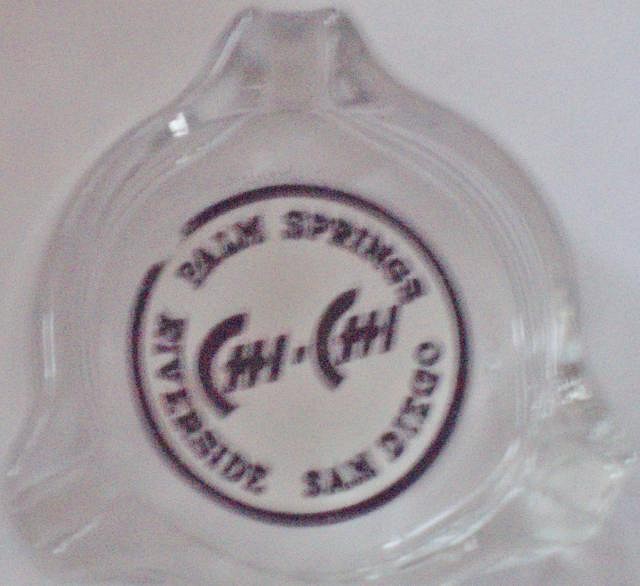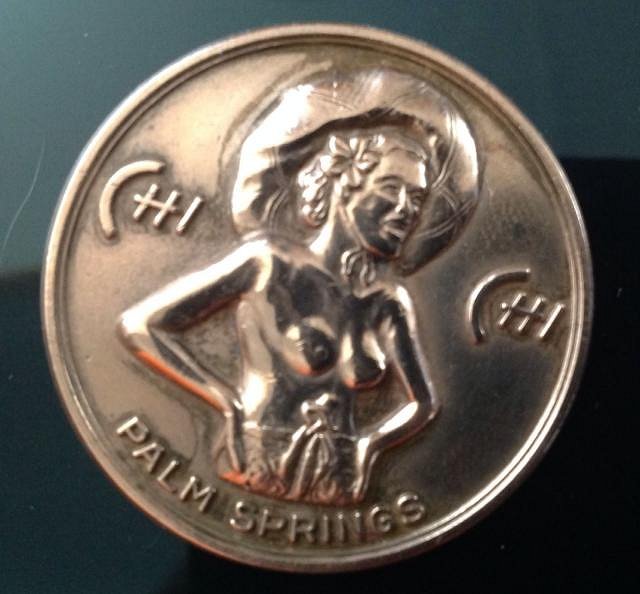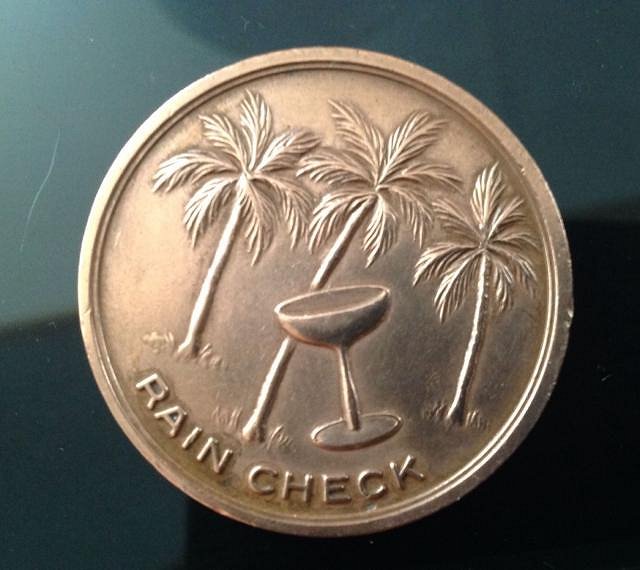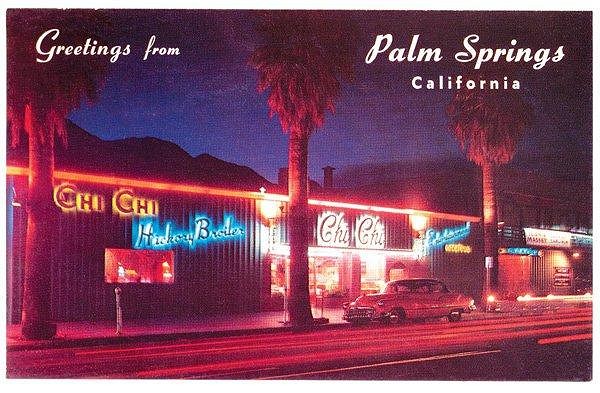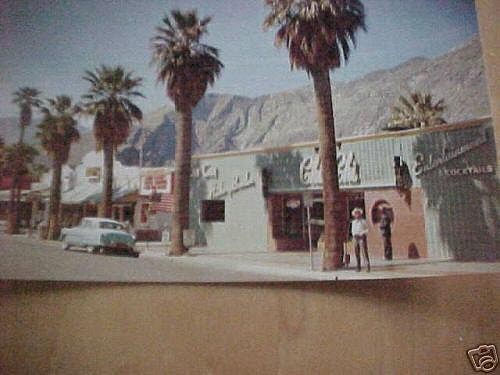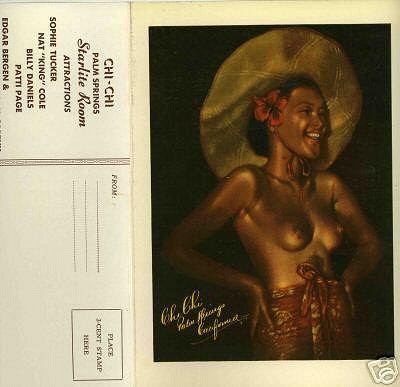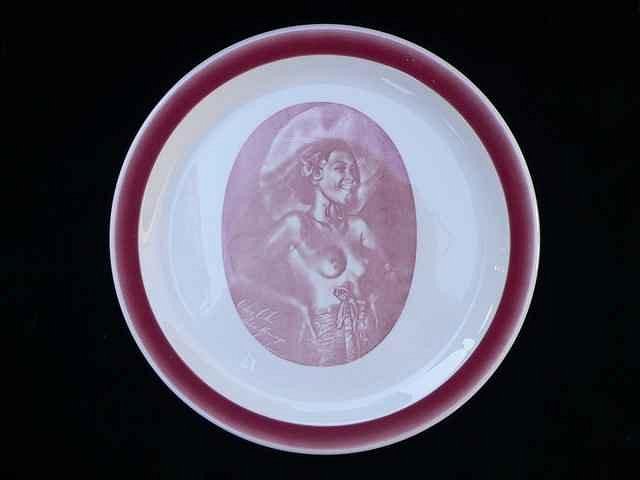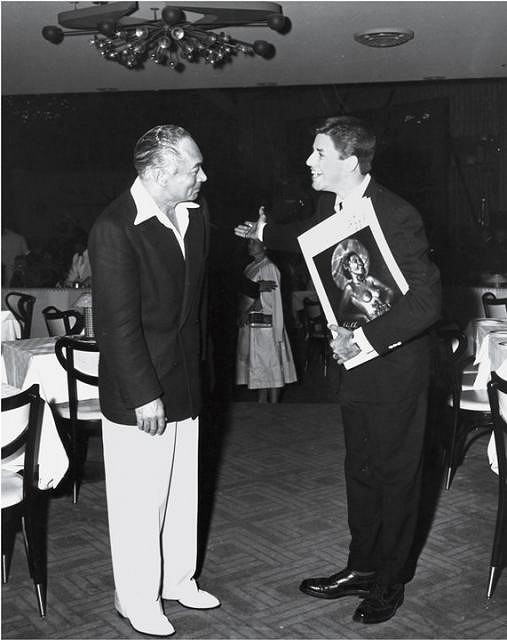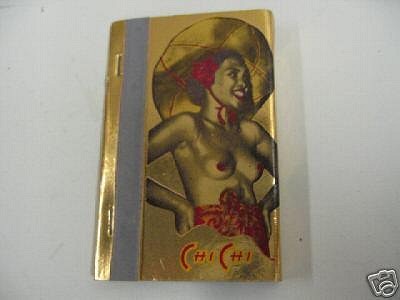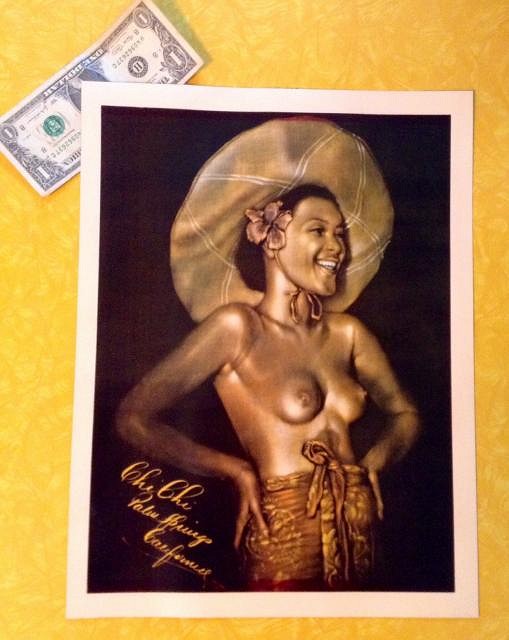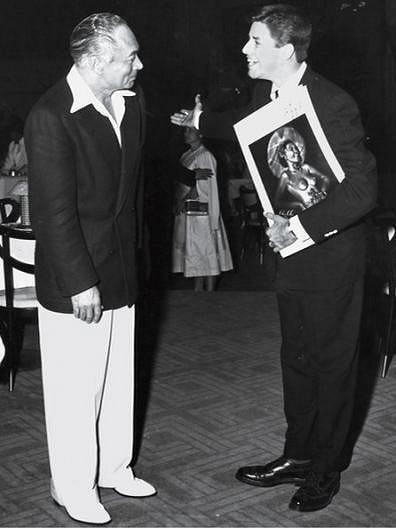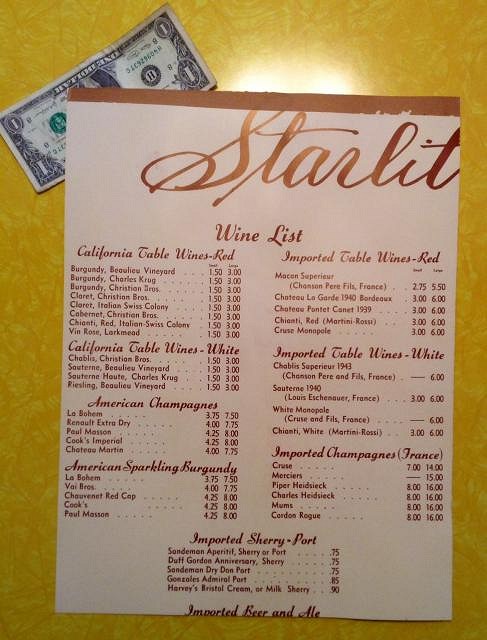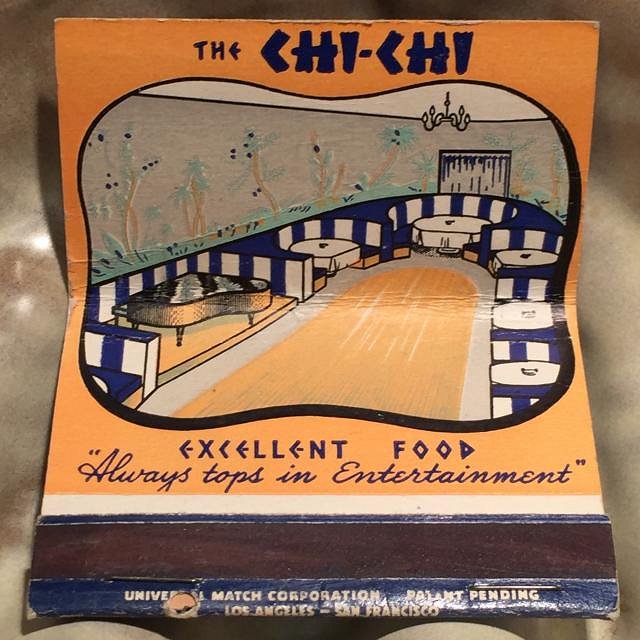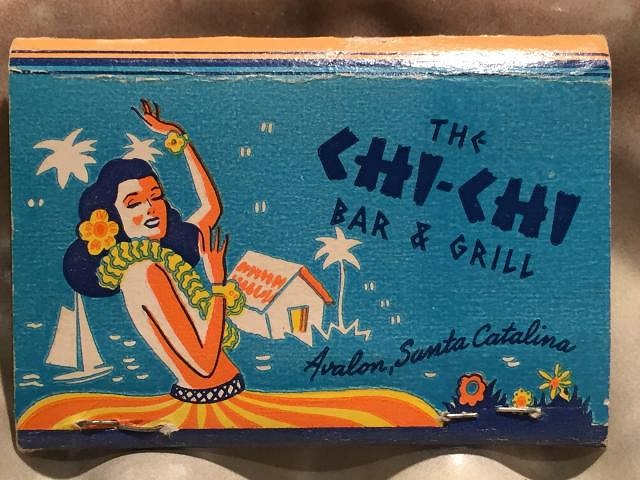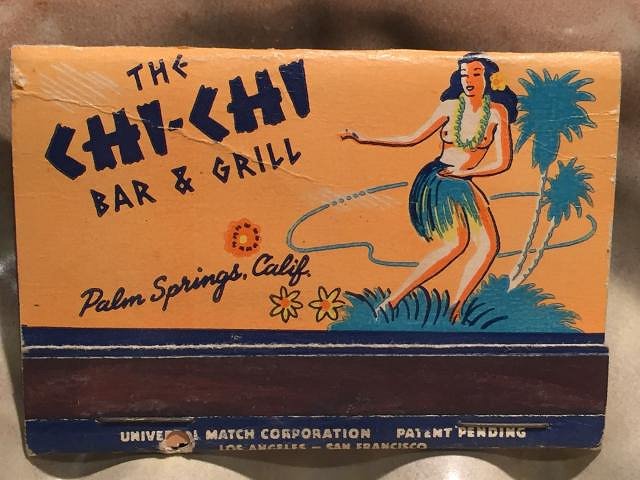Tiki Central / Locating Tiki
Chi-Chi, Palm Springs, CA (restaurant)
Pages: 1 12 replies
|
T
TikiTacky
Posted
posted
on
Sat, Jun 14, 2014 6:59 PM
Name:Chi-Chi Description: Whether your favorite groove is flying to the moon, or it’s one for the money, two for the show, there’s no better place to jump, jive, an’ wail than the Coachella Valley — home to such present-day entertainers as Suzanne Somers, Barry Manilow, Keely Smith, Brian Setzer, Jack Jones, and Merv Griffin. They’re not the only ones who’ve declared the desert home. Bob Hope, Bing Crosby, and Liberace loved it here. So did Ol’ Blue Eyes, Sammy Davis Jr., and Dean Martin. That’s why they made the desert their playground for more than three decades. When these legendary performers hit the town, it was party time — and the music never stopped. There was no stage or bandstand off limits to old ski nose, the king of rock ’n’ roll, or Frank and his friends. And their No. 1 hangout was the Chi Chi in downtown Palm Springs. The media described this giant supper club as “The second biggest nightclub west of the Mississippi,” where some of the brightest names in showbiz gathered for more than 25 years. Bigger than Ciro’s, better than the Trocadero, and more fun than the Mocambo that jammed L.A.’s Sunset Strip, the Chi Chi was a veritable shrine to “live” entertainment. Located on Palm Canyon Drive, it was the scene of many outstanding debuts, several exciting comebacks, and a few tearful farewells. Practically any New York and Las Vegas headliner that ever took a bow performed at the Chi Chi in its heyday: song and dance pioneers such as Eddie Cantor, Sophie Tucker, Rudy Vallee, the Ritz Brothers, Lena Horne, and Mickey Rooney, along with virtuoso performers such as Tony Martin, Jane Russell, Hoagy Carmichael, Rosemary Clooney, Johnny Mathis, and Peggy Lee. And let’s not forget those masters of Dixieland, bebop, and swing: Cab Calloway, Louis Armstrong, Ella Fitzgerald, and Duke Ellington. They shared the Chi Chi stage with the big bands of Gus Arnheim, Xavier Cugat, and Louis Prima. Comedy shtick came in appreciable doses from Edgar Bergen, Red Skelton, Martha Raye, Jerry Lewis, Phyllis Diller, and Jackie Mason. The list goes on and on. Success, of course, didn’t come overnight to the Chi Chi. It took years of careful planning and rehearsal before the neon signs were switched on and ticket buyers lined up, eager to pay the nightly cover charge of $5.50 per show. The Chi Chi opened in 1936 as the Desert Grill, a trendy café owned by Jack Freeman. Eventually, Freeman sold his financial interest in the profitable eatery to his business partner, Irwin Schuman, who revamped it as a fancy Polynesian-style restaurant and bar. Schuman christened his new venture Chi Chi Grill Cocktail Lounge — inspired by an exotic portrait of a topless Hawaiian girl painted by Edgar Leeteg he’d seen in an art gallery on a trip to Honolulu. The Chi Chi was not the first restaurant to use stylized recreations of palm-thatched roofs, tapa cloth, and velvet backdrops, but it was among the earliest and certainly one of the best when it opened in 1941. With an innate sense of style and showmanship, Schuman spent big bucks to indulge his customers’ fantasies of Balinese dancing girls and Fijian fire-eaters. Credit for the club’s name also has been attributed to Palm Springs artist Jack Church, who reportedly dubbed the painting “the Chi Chi girl” because of her sexy expression. For good luck, Schuman displayed a copy of Leeteg’s portrait, Hina Rapa, on the wall of his cocktail lounge. Onlookers found the image of the smiling native girl so captivating that Schuman blithely had it reprinted on cocktail napkins, dishware, glasses, matchbooks, swizzle sticks, menus, and playing cards. These dinner-table items quickly became prized souvenirs. “I did not give Chi Chi permission to use my Hina Rapa to reproduce in any way,” complained Leeteg in an angry letter from his home in Tahiti. “The least they could do is to give me a credit line, but that is too much to expect from a Hollywood gin mill.” The unexpected controversy helped publicize the tropical-themed restaurant; and Schuman opened a second Chi Chi bar in 1946 on Santa Catalina Island, where day-trippers ordered mai tais and ham steaks with pineapple. More locations followed in Riverside, Hollywood, Long Beach, and San Diego. During and after World War II, the Chi Chi became a favorite destination for U.S. servicemen, who crowded the bar, drank, and danced with local girls on weekends. Couples listened to swing music, did the jitterbug, and smooched at corner tables. Meanwhile, the Palm Springs flagship of Schuman’s enterprise continued growing in leaps and bounds. To meet increased customer demand, Schuman bought up surrounding businesses on Palm Canyon Drive and expanded his restaurant. The Blue Room — an elegant dining room that opened in 1948 — boasted crystal chandeliers, palm tree murals, full-size portraits of nubile island girls, plush red leather banquettes, doll-faced cigarette girls, handheld telephones, and a five-piece rumba band. “They had a maitre d’ and a front desk with three or four bell captains in tuxedos,” recalled late band leader Bill Alexander. “It was a real Vegas-style operation.” But Schuman was hardly finished. He wanted to stay ahead of the competition posed by restaurants such as Don the Beachcomber and Trader Vic’s. So he forged ahead, ripping out walls and adding more seating to accommodate the sellout crowds. By the time he was done, Schuman had rebuilt his restaurant several times. He wasn’t happy until he had a lavish showplace that was the envy of every club owner on the West Coast. Soon, theatrical agents were beating a path to the Chi Chi and begging Schuman to book their acts. In the main showroom, beyond two sets of polished front doors, a motorized velvet curtain could rise or drop over a circular stage large enough to hold a symphony orchestra. With the push of a button, a retractable dance floor disappeared under the stage, revealing a shimmering ice rink below. Knowing the importance of high-quality food, Schuman hired the head chef from the Florentine Gardens on Hollywood Boulevard to create a first-class menu, consisting of New York steak, filet mignon, broiled lamb chops, baked chicken, jumbo shrimp, marinated herring appetizers, and imported Camembert and Roquefort cheeses. Live Maine lobsters were flown in daily on special flights. On Oct. 10, 1950, the Chi Chi’s houselights were dimmed, and an amber spotlight illuminated the center stage of the newly completed Starlite Room, where 500 VIPs and celebrities sat shoulder-to-shoulder, white-linen-covered tables packed with bottles of Champagne, highballs, and Cuban cigars. A timpani drum roll hushed the excited audience as the curtain rose to reveal bouquets of tropical orchids, birds of paradise, stuffed green macaws, and the evening’s star attraction: Desi Arnaz wearing a straw hat and twirling a cane, accompanied by his 17-piece orchestra. Arnaz welcomed the distinguished guests, many of whom had traveled by plane, train, and automobile for the special occasion. He then grabbed a conga drum, flashed a wicked grin, and launched into a pulsating rendition of his chart-topping song “Babalu.” The audience stomped and hollered their approval. “Busby Berkeley,” Arnaz yelled over the microphone, referring to the movie director and choreographer of kaleidoscopic Hollywood musicals, “eat your heart out!” Sitting in the front row on that unforgettable opening night was Arnaz’s wife, Lucille Ball, wearing a pink chiffon evening gown. Arnaz dedicated a medley of songs to his beloved redhead and blew her a kiss. The historic evening had a tremendous impact on the city’s future. “Charlie Farrell founded the Racquet Club, but it was Irwin Schuman who turned Palm Springs into a worldwide tourist resort,” says Maxine Lewis, who booked entertainment for the Chi Chi’s early years. Under Schuman’s influence, the Chi Chi developed a reputation for showcasing top-notch talent. Handpicked groups of cabaret performers, Broadway actors, opera singers, vaudeville dancers, circus acrobats, impressionists, mimes, and magicians played his club to standing-room-only crowds. In 1954, Schuman enlarged the club’s seating capacity to 800 and penned a new advertising slogan — “California’s largest and gayest supper club” — that appeared in newspapers from Milwaukee to Miami. He may have been raking in the dough, but the expensive overhead caused some observers to wonder if the club was a cash cow or a money pit. The entertainment certainly didn’t come cheap. Milton Berle was paid $40,000 for a one-week engagement. Ray Bolger earned $20,000. Danny Thomas was offered $15,000, but turned it down. Liberace, who was only starting out, collected $1,500 a week playing Chopin in the club’s Persian Room. The Chi Chi took some big risks. Mae West’s campy nightclub act consisted of six bulging musclemen parading around the spot-lit stage in leopard-skin loincloths, while black comedienne Louise Beavers, dressed in a maid’s uniform, served tea to West, who reclined enticingly on a chaise lounge covered in eiderdown. Cary Grant raved about the show for weeks. Ann Sheridan also was a big fan. Mafia boss Sam Giancana, a veteran of more than 70 police arrests with links to organized crime stretching across three states, took a special interest in the singing careers of the McGuire Sisters when they played the Chi Chi. He was so smitten by Phyllis McGuire, the youngest of the satin-gowned trio, that he ordered fresh flowers sent to her dressing room at every performance. Schuman caused a commotion when he booked striptease artists Gypsy Rose Lee, Tempest Storm, and Lili St. Cyr and her foaming bubble bath. Police fined him $500 when Sally Rand performed her risqué fan dance in the nude. On the lighter side, there was yodeling singer Dorothy Shay, billed as “the Park Avenue Hillbilly”; the cavorting Marquis Chimps; and George Arnold’s spectacular Rhythm on Ice with a cast of 12 championship skaters. By 1955, the Chi Chi was the epitome of desert swank. Klieg lights pierced the evening sky as gorgeous movie stars arrived in chauffeured limousines, shiny sedans, and convertibles to catch the latest big act. Hollywood sweethearts Tony Curtis and Janet Leigh and Robert Wagner and Natalie Wood posed for photographers. Rock Hudson, Marilyn Monroe, and William Holden signed autographs. Brazilian bombshell Carmen Miranda played one memorable New Year’s Eve bash at the Chi Chi, complete with tin horns, confetti, and fruit baskets on every table. She sashayed her way across the stage, followed by seven brightly costumed Carioca boys shaking maracas. At midnight, partygoers in fancy dress danced the cha-cha, samba, and mambo. A sparkling attraction opened at the Chi Chi every week. Top-selling recording artists Mel Tormé, Betty Hutton, Vic Damone, Jane Powell, and Gordon MacRae made way for the Andrews Sisters, the Mills Brothers, Anna Maria Alberghetti, and Donald O’Connor. Thrilling jazz and pop concerts were given by Sarah Vaughan, Billy Eckstine, Julie London, Herb Jeffries, Della Reese, Frankie Laine, Patti Page, Wayne Newton, Mamie Van Doren, and many others. Reservations were essential. “We’d go to dinner with Humphrey Bogart, Ronald Reagan, Errol Flynn,” recalls comedian-singer-actor Peter Marshall. “It would be packed.” Men wore tailored Sy Devore and Don Loper suits; women modeled cocktail dresses by Elsa Schiaparelli and Christian Dior. For more than a decade, the Chi Chi lived up to its latest claim as “Showplace of the Stars.” One of those dazzling stars was Eartha Kitt, who once said, “The Chi Chi is where I made my favorite album, titled Eartha Kitt at the Plaza. The album is called this because RCA thought the public would not know the name Chi Chi, whilst the Plaza and the Persian Room (in New York) are household names.” But racial tensions lurked beneath the desert’s sophistication. Nat King Cole’s soothing rendition of “Nature Boy” almost didn’t happen at the Chi Chi because of widespread boycotts. Schuman received death threats when he booked Cole and his 25-piece orchestra, and no hotel in the city would give him a room. So Schuman had to put Cole up at his home instead. Still, the Cole shows sold out. At other times, sympathy triumphed over prejudice. “Ladies and gentlemen, please welcome the greatest entertainer in the world, Sammy Davis Jr.!” Bill Alexander’s orchestra struck up the first few bars of the song “Mr. Wonderful”; and Davis, in one of his first concerts since losing his left eye in a freak automobile accident on Route 66 near San Bernardino, bounded onto the stage. For the next two hours, the grinning, energetic performer sang, danced, and wowed the capacity first-night crowd with clever impressions of boyhood idols Bill “Bojangles” Robinson and James Cagney. Sitting ringside, applauding loudly from their seats, were Jack Benny, Lana Turner, and Clark Gable, who marveled at Davis’ physical agility. The show received a standing ovation. Schuman’s remarkable accomplishments earned him numerous civic honors that he humbly accepted on behalf of his hardworking entertainers and staff. Unfortunately, the Chi Chi’s high times were contrasted by a few terrible lows. In 1960, Dorothy Dandridge accepted a last-minute booking to replace MGM’s temperamental singing star Kathryn Grayson, who had taken ill. Her voice was not at its best, however, due to emotional problems, and the show was poorly reviewed. Two years later, Dandridge bravely returned to Chi Chi’s stage for a limited eight-day engagement — one of her last public appearances. Looking stunning in a white, body-hugging Travilla gown, she mesmerized the audience with sensitive renderings of wistful songs such as “What is This Thing Called Love?” After the show closed, Dandridge threw a party for the orchestra and slowly got drunk on Champagne. Another popular Chi Chi attraction, Marie McDonald, suffered a more pathetic fate. In 1957, the shapely star — once touted by Hollywood press agents as “the Body” — was discovered wandering in a daze, clad only in pajamas, along a road near Indio. McDonald told reporters she had been kidnapped, but had managed to escape her captors. Later she admitted it was a hoax. As the Chi Chi’s biggest decade came to a dramatic close, so did its record-breaking attendance. The mushrooming popularity of television, combined with changing public tastes, kept many people at home. These and other economic factors signaled the sad demise of the great nightclub era. In 1959, the same year Ciro’s filed for bankruptcy, Beverly Hills restaurateur Michael Romanoff, in a bid to recapture his past glories, opened Romanoff’s-on-the-Rocks on Highway 111 in Cathedral City. At the same time, Charlie Farrell quietly sold the Racquet Club for $1.2 million. Schuman, meanwhile, expanded his horizons and began construction on the Riviera Hotel in Palm Springs. The hotel’s centerpiece, the Mediterranean Room, became the new venue for Rat Pack gatherings, charity fundraisers, and fashion shows. Romanoff’s bid to cash in on the nightclub boom was a failure, however, and he sold his restaurant. In 1966, George Arnold leased the Chi Chi from Schuman and presented The Follies de Pigalle, starring Denise Darcel and a cast of 40. Two years later, Seymour Weiss, owner of the International House of Pancakes, took over the club and turned it into a discothèque. “Bob Hope was still making surprise appearances, driving his Chrysler,” remembers club promoter Bob Horn. “Steve McQueen would come in to pick up girls. Frank Sinatra liked to sit at the bar and catch new acts.” Schuman had seen the writing on the wall and got out in time. After several changes of ownership, the Chi Chi’s unfortunate end came on a hot summer’s day in 1977. The enormous building was torn down, its massive center stage, wings, and tiered seating leveled to make way for a modern shopping center, the Desert Fashion Plaza. Today, the Chi Chi is a distant memory, but its influence is still felt across the valley. New generations of nightclubbers have rediscovered the fun of having the world on a string and are busy living it up. Their favorite hangouts include the Casablanca Lounge at Melvyn’s, the Citron Bar at Viceroy Palm Springs, and the lobby of Parker Palm Springs. A prime example of retro desert chic was Muriel’s Supper Club, which opened in Palm Springs in 1999. It helped spearhead a revival with show-stopping appearances by Eartha Kitt, Nancy Sinatra, and k.d. lang, the latter of whom serenaded 200 fans there in November 2000. After Muriel’s changed its name to Atlas, the gleaming two-story nightclub underwent a third transformation. It’s now CopyKatz Showroom and Backstage Bistro, where look-alike performers portray such icons as Barbra Streisand, Michael Jackson, Cher, and Madonna. In a similar vein, Buddy Greco’s Dinner Club, a cozy 90-seat restaurant complete with a bandstand where the internationally renowned Greco and his wife, Lezlie Anders, schmooze tables of admirers while singing at the piano, opened in Cathedral City in 2006. That same year, Bing Crosby’s Restaurant and Piano Lounge (the second of five planned nationwide), bearing the likeness of Crosby and featuring live music nightly, began welcoming customers in Rancho Mirage. So remember the good times — and let ’em roll!" --- From http://www.palmspringslife.com/Palm-Springs-Life/September-2007/In-the-Swing/
[ Edited by: TikiTacky 2014-06-14 19:00 ] |
|
T
TikiTacky
Posted
posted
on
Sat, Jun 14, 2014 7:02 PM
Their marketing materials certainly have a tiki flair, but I'm not finding much of the interior. The one picture they had on the page I linked to doesn't look tiki at all, but the article says "The Chi Chi was not the first restaurant to use stylized recreations of palm-thatched roofs, tapa cloth, and velvet backdrops, but it was among the earliest and certainly one of the best when it opened in 1941. With an innate sense of style and showmanship, Schuman spent big bucks to indulge his customers’ fantasies of Balinese dancing girls and Fijian fire-eaters." "You can't eat real Polynesian food. It's the most horrible junk I've ever tasted." —Trader Vic Bergeron [ Edited by: TikiTacky 2014-06-14 19:03 ] |
|
PP
Pele Paul
Posted
posted
on
Sun, Jun 15, 2014 9:54 PM
wow great read!!!! thanks for posting, now Ive gotta find pix of the inside!!! |
|
T
TikiTacky
Posted
posted
on
Mon, Jun 16, 2014 7:59 PM
"Remembering The Chi Chi BY JANICE KLEINSCHMIDT In the 1940s and ’50s, the Chi Chi was “a hip little place to come for wealthy people,” Bill Alexander says. The Palm Springs resident should know. He saw a lot during more than 15 years he played drums and served as musical director at the Palm Canyon Drive supper club. A Chi Chi promotional piece floats faces of stars appearing at the Chi Chi, including Jerry Lewis, Sophie Tucker, Louis Armstrong, Edgar Bergen, Nat King Cole, Dorothy Dandridge — “and for your dancing pleasure, Bill Alexander and his orchestra.” Alexander played the Starlite Room, so named for the dome with twinkling lights above the circular stage. He started in 1947 at the age of 20, fresh from the Army. From 1950 until the club closed in 1965, he held sway seven nights a week, 10 months of the year. In season, affluent world citizens wined, dined, and danced at the Chi Chi. “It was just a very, very high-class, sophisticated audience,” Alexander says. “It was a tough room in a some ways.” But Lena Horne, whom Alexander says gave one of the best shows he ever played in his life, “cast a spell on the audience.” Season dictated the size of the orchestra. From Labor Day to Thanksgiving, Alexander headed a five-piece orchestra. After Thanksgiving, the orchestra expanded to seven pieces. But in summer, it shrank to three musicians playing in the smaller “front bar.” From Christmas to Easter, customers were dressed to the nines. “The hat check girl would have a million dollars of fur coats,” Alexander says. “It was fun to just go by and look at the furs. They were so beautiful.” From Labor Day until the Fourth of July, the Starlite Room hosted those in the movie industry — from actors to directors and producers to studio heads such as Jack Warner and Cecil B. DeMille, a lot of real estate professionals entertaining clients, and wealthy Los Angeles businessmen. Shows started at 9 p.m. and midnight. “I used to stall the shows for 15 or 20 minutes if we had a big crowd,” Alexander says. “That way, they would drink more for the boss.” He would have the band warm up or he would go to the maitre d’ station and pick up the phone. So long as the audience saw something happening, they were content to wait. “The boss” was Irwin Schulman, whom Alexander calls “a very gracious guy” with a lot of friends and connections, including Howard Hughes, a frequent Chi Chi guest. A paranoid hypochondriac who rented three homes in Palm Springs, Hughes would call Schulman before coming to town and ask him to have Mary, a Chi Chi employee, disinfect one of the houses. When Hughes came to the Chi Chi with lovely young starlets, “the boss” ordered the band to play until he left. While they normally quit at 1:30 a.m., Alexander says, they would have to play another hour or more while Hughes seduced his female companion in a back booth. The Chi Chi also attracted notable Mafioso, such as Sam Giancana and Mickey Cohen. Two plainclothes cops came in at least three times a night, and “the help” would inform them of hoods who had been in or “anything suspicious,” Alexander says. In the summer, a cop might come to the Chi Chi in uniform. “He would sit at the bar have a drink. Nobody thought anything about it,” Alexander says. Schulman generally got name acts at a discount. “We used to break in a lot of Vegas revues,” Alexander says. “Sometimes we had to rehearse two days because they would have new music.” Rarely did a show bomb, but when it did — as in the case of a New York opera star — Schulman would “pay them off.” Alexander recalls when the Chi Chi closed. “We hired the Milton Berle Revue for nine days for $45,000. I had a 25-piece orchestra, which cost around $8,000,” he says, noting that Berle “packed the joint.” But after the show, Schulman summoned Alexander to his office. “He said, ‘Bill, I am going to have to close the joint. You saw what we did. I really didn’t make any money. I took a helluva chance. What if they hadn’t stormed the gates to see Berle? I would have lost a fortune.’” During the last few years of the Chi Chi, Schulman built the Riviera hotel, and that’s where his friends visited him after the club closed. “It was an entirely different atmosphere than you get in show business today,” Alexander says wistfully. “It was like Camelot.”" http://www.palmspringslife.com/Palm-Springs-Life/February-2005/Remembering-The-Chi-Chi/ |
|
T
TikiTacky
Posted
posted
on
Tue, Jun 17, 2014 12:48 PM
A few items I found online. None of these are in my collection.
A matchbook which I do own: |
|
T
TikiTacky
Posted
posted
on
Thu, Jun 19, 2014 3:31 PM
A rain check token that recently sold on eBay:
|
|
1
1961surf
Posted
posted
on
Fri, Jun 20, 2014 1:28 PM
Here are several items from my collection of the "Starlite Room " Chi Chi Club Palm Springs
|
|
UT
uncle trav
Posted
posted
on
Fri, Jun 20, 2014 3:54 PM
Here is a remnant of that awesome menu that I have. A bit faded but the fact that it survived at all is amazing. That has to be one of the biggest menus made for a restaurant!
|
|
1
1961surf
Posted
posted
on
Fri, Jun 20, 2014 4:50 PM
That's awesome uncle trav . |
|
H

hang10tiki
Posted
posted
on
Mon, Feb 6, 2017 6:28 PM
Found one today
|
|
KBT3

King Bushwich the 33rd
Posted
posted
on
Fri, Jan 4, 2019 12:24 AM
Over the years, there were several Chi-Chi's. The last survivor is on Catalina Island
Including San Diego Classic San Diego- Chi-Chi club Anybody got information on the one in Long Beach (Belmont Shore)? |
|
H
hiltiki
Posted
posted
on
Thu, Jan 17, 2019 10:23 PM
Found these pictures online.
|
|
H

hang10tiki
Posted
posted
on
Tue, Mar 12, 2019 4:00 PM
Found here in Vegas
|
Pages: 1 12 replies





